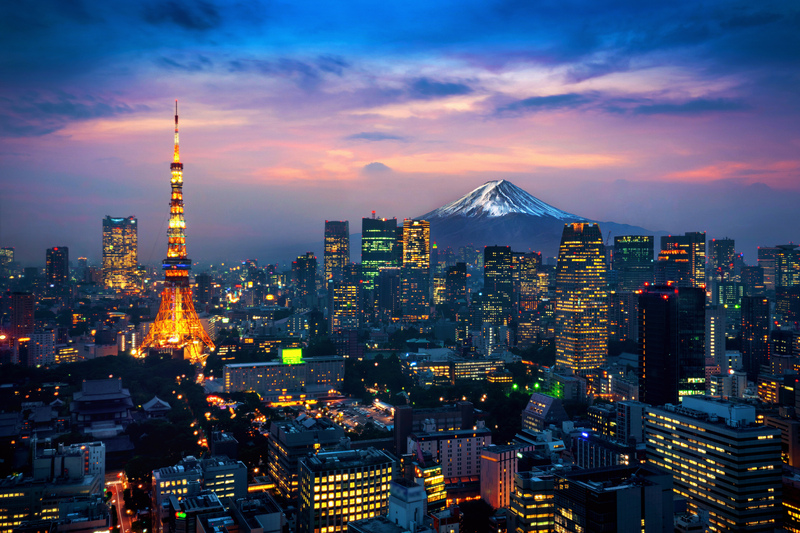Tokyo, the bustling and dynamic capital city of Japan, is perhaps the most fascinating and diversified city in the world. A city where ancient habits peacefully coexist with modern technology, Tokyo is the epitome of Japan’s cultural heritage and its progressive nature. Its brightly colored streets, historical temples, massive skyscrapers, and international neighborhoods render it a city that stands apart from others, drawing in millions of visitors and residents who are eager to experience its symphonic blending of the new and old.
Geographical and demographic overview
Situated on the eastern coast of Honshu, the greatest island of Japan, Tokyo is tactically located on the Pacific Ocean. As the core component of the Greater Tokyo Area, it is the most populous urban area in the world with an astounding population in excess of 37 million as of 2023. Occupying a sprawling area of nearly 622 square kilometers, Tokyo extends over a terrain made up of coastal plains, hills, and a little mountainous area. Its humid subtropical climate features hot and humid summers as well as mild winters. It experiences a rainy season from June to July and enjoys the infrequent typhoons that hit the area during the latter half of summer and the early part of autumn.
Historical background
Tokyo’s history is rooted in its past as Edo, a modest fishing village that developed into a capital political center during the Edo period (1603–1868). The city flourished as a powerful center when Tokugawa Ieyasu established the Tokugawa shogunate there in 1603, transforming Edo into a large urban metropolis with thriving cultural life. Following the Meiji Restoration of 1868, the city was renamed Tokyo, “Eastern Capital,” as the imperial capital was relocated away from Kyoto. This was the beginning of the speedy modernization, as Western technology and knowledge were integrated to make Tokyo a modern city with railways, contemporary skyscrapers, and administrative complexes.
The 20th century, however, was a period of upheaval for Tokyo. It survived the disastrous Great Kanto Earthquake of 1923, which caused havoc and destruction on a massive scale, and received severe damage from World War II in the shapes of bombing raids. But Tokyo’s strength lay in its rapid post-war reconstruction that positioned it for its emergence as an economic superpower of the world.
Economic significance
Currently, Tokyo is an economic powerhouse, contributing a lion’s share of Japan’s gross domestic product. Its financial district, the core of which is located near Marunouchi north of Tokyo Station, is home to numerous multinational corporations, banks, and trading firms. The Tokyo Stock Exchange, ranked as one of the world’s largest, underscores the city’s position at the center of global finance. The economy of the city is vastly diverse, ranging from technology and manufacturing to retailing and entertainment. The vibrant Akihabara neighborhood is one of the best representations of Tokyo’s influence on global pop culture, brimming with lots of electronic shops, manga and anime stores, and specialty restaurants. Conversely, districts like Shinjuku and Ginza are Tokyo’s modern sleek architectural wonders and high-end shopping districts, bearing testament to its status as a hub of innovation and wealth.
Cultural and tourist attraction
Tokyo’s cultural scene is highly varied and vast. The city boasts historic sights that stand as a proof of its extensive history, such as the Imperial Palace, Japan’s emperor’s residence. Surrounded by well-maintained gardens and moats, the palace is a sign of Japan’s imperial past. A short distance away is the Senso-ji Temple in Asakusa, Tokyo’s oldest temple, which is famous for its high Kaminarimon gate and busy Nakamise shopping street lined with traditional souvenirs and snacks.
On the modern side, Tokyo boasts such great landmarks as the Tokyo Skytree, at 634 meters one of the tallest towers in the world, which offers panoramic city views. Tokyo Tower, a replica of Paris’s Eiffel Tower, remains the city’s symbol. Both are examples of Tokyo’s penchant for combining architectural innovation with cultural symbolism. The city’s districts are as diverse as its landmarks; Shibuya and Roppongi Hills are epitomes of contemporary urban existence with their tower blocks that seem to reach the sky, nightlife, and shopping districts. Shibuya’s scramble crossing, widely quoted by the media as the busiest intersection in the world, is the very essence of Tokyo’s frantic pace.
The city also appreciates its cultural institutions and museums. The Tokyo National Museum contains a huge repository of Japanese historic artifacts and art, and the Mori Art Museum displays international contemporary works. The Edo-Tokyo Museum offers windows into the city’s transformation from Edo to modern-day Tokyo, offering visitors a glimpse into its history.
Region-specific neighborhoods
Region-Specific Neighborhoods
Tokyo neighborhoods are no less diverse than the city’s cultural attractions. Shinjuku, home to its colossal train station—world’s busiest—is the gateway to the city’s energetic urban culture. It is a shopping, entertainment, and nightlife center with thousands of bars, restaurants, and entertainment venues. Shinjuku Gyoen National Garden offers a serene retreat amidst the city’s chaos, a green paradise where one can unwind and appreciate seasonal cherry blossom viewing.
Harajuku is renowned for its dramatic youth fashion, quirky boutiques, and street life. Takeshita Street is full of fashion trends, while Meiji Shrine nearby offers a peaceful retreat with traditional structures and high-density forested terrain. Akihabara is a paradise for shoppers of electronics, anime, and manga items, with thousands of stores, theme cafes, and arcades that are Japan pop-culture obsessed.
Asakusa, steeped in history, offers a nostalgic perspective of the old Tokyo. Its Senso-ji Temple is a famous pilgrimage site, and the surrounding streets are lined with antiquated shops that sell souvenirs, street food, and handicrafts. Tsukiji Market, and its newer counterpart, Toyosu Market, are world-famous for their fresh seafood and sushi and are frequented by foodies all over the globe.
Odaiba, a man-made island in Tokyo Bay, is the epitome of Tokyo’s forward thinking. It has cutting-edge shopping malls, entertainment complexes, and visitor attractions such as the replica Statue of Liberty and the beautiful Rainbow Bridge. Odaiba is a prime example of the way in which Tokyo keeps embracing technology and entertainment, making these spaces accessible to locals and tourists alike.
Transportation infastructure
Tokyo’s transport system is one of the most sophisticated and efficient in the world. The large railway and subway networks, run by several companies like JR East and Tokyo Metro, carry millions of daily commuters to cover the city’s spread-out districts with ease. The network’s punctuality and reach are the stuff of legend, making it easy for city dwellers and tourists to move about. Buses and taxis also supplement the train system to open up the areas beyond the train routes.
It has two principal airports: Narita International Airport, which is where the majority of international flights arrive, and Haneda Airport, closer to the center of the city and increasingly important for domestic and international air travel. Both airports have efficient modern infrastructure and transport links, such as trains and buses, to access the city.
Despite its population numbers, the city planning in Tokyo revolves around parks and state-of-the-art architecture. The city’s disaster preparedness, especially considering Japan’s seismic history, includes advanced building standards, warning systems, and public safety features making the city the world’s safest big city.
Cuisine and culinary culture
Tokyo cuisine is famous worldwide with an endless variety of dining places ranging from street food stalls to Michelin-starred restaurants. Japanese cuisine like sushi, tempura, ramen, and soba are easily available and are often prepared with excellent skill and freshness. Tokyo’s various markets, including Tsukiji and Toyosu, are famous for seafood as well as fresh vegetables and fruits and are a heaven for gourmets.
The city’s neighborhoods each have their own culinary identities. Shinjuku and Shibuya have relaxed restaurants, izakayas, and cafes, serving everything from grilled skewers to international food. Omoide Yokocho, a cramped, tight alley filled with tiny bars and street stalls, gives a true taste of the city lifestyle and traditional food. In contrast, upscale districts like Ginza have room for luxury restaurants and innovative fusion cuisine, reflecting Tokyo’s status as a gastronomic capital.
Apart from its traditional cuisine, Tokyo is also a hub for themed cafes, bakeries, and unconventional food excursions. The city’s food creativity results from a new generation of young individuals who are eager to venture into new horizons in food, thereby turning Tokyo into foodies and trendsetters’ haven.
Festivals and events
Tokyo’s festival calendar is rich in celebrations of its traditional heritage and contemporary energies. Of the city’s most colorful celebrations is the Sanja Matsuri at Asakusa Shrine in May, featuring classic mikoshi parades, music, and dance. The Tokyo International Film Festival, annually, welcomes filmmakers and moviegoers from all over the globe, showcasing fresh talent along with international films.
Spring cherry blossom is so lovely to look at that gardens like Ueno and Yoyogi turn into breathtaking landscapes of white and pink flowers. Locals and foreigners alike throng for hanami picnics beneath the blooming trees during those short weeks, filling the air with good vibes that mirror the city’s appreciation of nature and tradition. New Year’s celebrations are also a key aspect, with thousands of people gathering at the Imperial Palace to witness the emperor deliver his New Year’s address and partake in traditional rituals.
Challenges and future prospects
Though it has many strengths, Tokyo has some challenges. Its population has led to congested streets and public spaces, and the population aging also poses long-term demographic challenges. Climate change and natural disasters, including earthquakes, require ongoing expenses on infrastructure, disaster prevention, and sustainability.
The city is working on smart city technology, renewable energy projects, and urban regeneration plans in earnest to counter these issues. Tokyo’s successful hosting of the 2020 Summer Olympics, delayed to 2021 due to the pandemic, was a testament to its resilience and potential for innovation as a global leader in culture, tech, and urbanism.
Gazing to the future, Tokyo expands and matures, embracing new fashions while honoring its past. Its ability to embrace change and innovation ensures that it will stand as a reflection of Japan’s dynamic character—a cityscape in which tradition is woven beautifully together with modernity.
Conclusion
Tokyo is a city that intrigues through its refinement and paradoxes. It is a city that juxtaposes traditional temples and serene gardens alongside monumental skyscrapers and bustling shopping districts. Its diverse neighborhoods also have their own tales, embodying the city’s multifaceted identity. Whether exploring its historical landmarks, indulging its cuisine, or marveling at its technological prowess, tourists and natives alike find themselves in a city that never ceases to inspire. As Tokyo continues to grow and develop, it remains a testament to the power, intelligence, and boundless energy of Japan—a city as timeless as it is contemporary.

